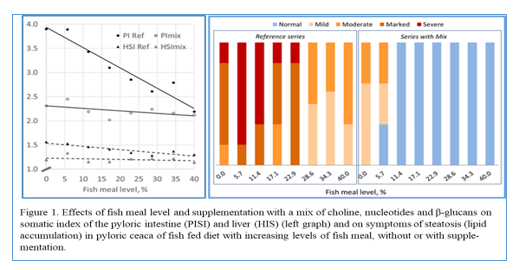GUT HEALTH EFFECTS IN ATLANTIC SALMON Salmo salar L. OF LOW DIETARY FISH MEAL LEVEL CAN BE LIMITED BY DIETARY SUPPLEMENTS
Introduction
A survey of gut health at three timepoints during one year after sea transfer, in six Atlantic salmon farms along the coast of Norway , conducted in the years 2018 to 2019, showed frequent signs of steatosis in the proximal intestine and inflammation in the distal intestine (Kortner et al. 2021) . A controlled experiment was conducted to find if low level of fish meal in the diet might explain these findings. A second goal was to find if the symptoms might be diminished by supplementation with choline, known to be necessary for efficient lipid transport in the intestine, and nucleotides and β-glucans, claimed to improve gut immune status.
Materials and methods
Two diets series were made. Each comprised eight diets in which fish meal levels varied from 0 to 40%, replacing a mixture of plant protein sources. O ne series was made without supplementations (Ref) , the other was supplemented with a mixture (Mix ) of 3000 ppm choline chloride, 500ppm nucleotides (Lallemand®) and 500ppm β-glucans (Biorigin®). The diets were fed for 62 days to Atlantic salmon in tanks with salt water, 45 fish per tank with average start weight 186g, final weight 511g. At termination of the feeding period, from 12 fish per tank, whole body and carcass weight and body length were measured, and blood samples taken for observation of plasma biomarkers of nutritional status . These fish were divided in two groups of six fish. From one of these groups, samples of digesta and mucosa were taken for observation and analyses of weight of liver, pyloric region, mid and distal intestine, activity of digestive enzymes and concentration of bile salt . From the other group, samples were taken from the mucosa of the pyloric and distal intestine for histology and gene expression analyses, and from the digesta for metabolome and microbiota analyses.
Results
Neither dietary fish meal level nor the Mix supplementation affected growth or feed conversion ratio significantly . Fish fed the Ref diet series, showed significant effect of fish meal level on the somatic indices of the pyloric intestine (PISI) and liver (HSI) (Fig. 1, left), and the difference between the two diet-series was significant for both. The Mix decreased the indices greatly, most pronounced for the PI, and the dose-response effect of fish meal level, almost disappeared . Results of histological evaluation of the PI of the fish showed severe steatosis in fish fed low fishmeal diets without Mix (Fig. 1, right), decreasing with increasing fish meal level . P revious studies of effects of supplementation with choline alone, have shown similar effects on PISI. Our conclusion is, therefore, that the present results confirm that low fish meal diets are choline deficient. The results indicated that the level of choline in the diet with 11.4% fish meal in the supplemented series, contained sufficient choline for efficient lipid transport across the intestinal mucosa. Analyzed value of choline in this diet was 4240 ppm, a number substantially higher than the 3400 ppm estimated to be required in the study by Hansen et al (2020) .
Increasing level of fish meal did not clearly affect histological signs of inflammation in the distal intestine, which in general were very mild, without or with the Mix in the diet.
Expression of genes in the mucosa of the distal intestine, showed clear correlation with fish meal level for many genes of key importance in digestive and immune functions. The effects tended to diminish with increasing fish meal level. Table 1 shows correlation coefficients (Pearson) for a number of functional groups. The results also showed that the M ix modulated these effects and reduced the effects of fish meal level.
The results of the metagenome analyses showed increasing α-diversity, i.e. number of different bacteria with increasing level of fish meal. However, supplementation with the Mix eliminated this effect and reduced α-diversity at high fish meal levels . Also, β-diversity, taking into account which bacteria were present, differed between fish fed low and high fishmeal diet, and, again, the Mix diminished this effect.
Literature
Hansen, A.K.G. et al . 2020. Dose-response relationship between dietary choline and lipid accumulation in pyloric enterocytes of Atlantic salmon (Salmo salar L.) in seawater. Br. J. Nutr. 28;123:1081-1093.
Kortner, T. M. et al . 2021. Diet composition, growth, gut function, and gastrointestinal pathologies of farmed atlantic salmon from six sites along the N orwegian coast during seawater grow-out. Presentation at EAS conference, Madeira.

